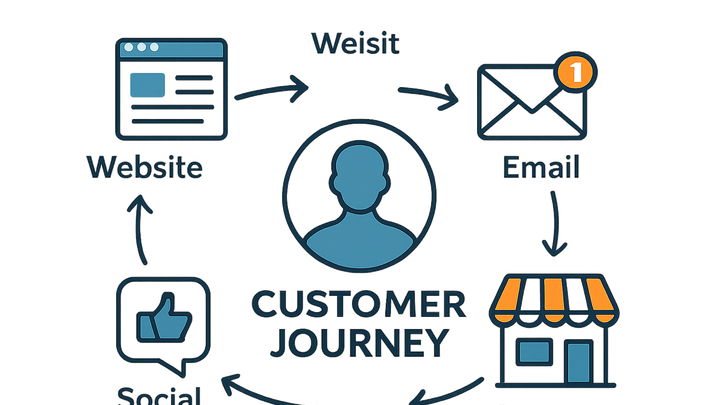Published on 2025-06-26T04:30:52Z
What is a Touchpoint? Examples for Touchpoint in Analytics
A touchpoint is any instance of interaction between a user and a brand across any channel, from digital to offline. In analytics, touchpoints serve as discrete data points along the customer journey, marking each engagement event—such as pageviews, clicks, form submissions, email opens, in-store visits, and more. Capturing and analyzing these touchpoints enables marketers and analysts to understand user paths, optimize funnels, and allocate attribution credit effectively across channels. With the shift toward privacy-centric, cookieless tracking, solutions like PlainSignal offer simple analytics without relying on cookies, while platforms like GA4 leverage an event-based model for comprehensive measurement. Proper implementation of touchpoint tracking lays the foundation for accurate customer journey mapping, advanced attribution modeling, and personalized marketing strategies.
Touchpoint
Discrete interaction points between a user and a brand, tracked across channels for journey mapping and attribution in analytics.
Defining a Touchpoint
Touchpoints are moments of interaction between a user and a brand. These can occur across digital channels—like websites, apps, or emails—as well as offline experiences, such as in-store visits or phone calls. Identifying and categorizing touchpoints is crucial for mapping the customer journey and informing data-driven decisions.
-
Digital touchpoint
Interactions that take place on digital platforms, including websites, mobile apps, emails, and social media. Each action—like a pageview or button click—constitutes a touchpoint tracked via analytics tools.
-
Website pageviews
Each page load on your site captured by analytics scripts like PlainSignal or GA4 marks a foundational digital touchpoint.
-
Click events
Clicks on links, buttons, or call-to-action elements represent micro-interactions providing fine-grained insights into user behavior.
-
-
Offline touchpoint
Interactions outside the digital realm, such as in-person store visits, phone inquiries, or print ad engagements.
-
In-store visits
Physical store engagements tracked via methods like POS integrations or loyalty program check-ins.
-
Phone calls
Customer service or sales calls recorded and analyzed through call-tracking integrations.
-
Why Touchpoints Matter in Analytics
Analyzing touchpoints delivers critical insights into how users progress through the funnel. By examining each interaction, teams can identify friction points, tailor messaging, and make informed budget allocations. Moreover, understanding the sequence and frequency of touchpoints informs advanced attribution models, ensuring credit is properly assigned across all channels.
-
Customer journey mapping
Aggregated touchpoint data helps visualize the end-to-end path users take, revealing common routes to conversion and areas for optimization.
-
Attribution modeling
Assigns credit to individual touchpoints (first, last, or multi-touch) to measure channel performance and guide investment decisions.
-
Personalization and optimization
Real-time touchpoint insights enable dynamic content personalization and targeted remarketing based on user behavior.
Implementing Touchpoint Tracking with PlainSignal
PlainSignal provides a lightweight, cookie-free analytics solution for tracking touchpoints with minimal setup. The following steps outline how to integrate touchpoint tracking on your site.
-
Installing PlainSignal snippet
Add the following code to the
<head>of your HTML to install the PlainSignal tracking script:<link rel="preconnect" href="//eu.plainsignal.com/" crossorigin /> <script defer data-do="yourwebsitedomain.com" data-id="0GQV1xmtzQQ" data-api="//eu.plainsignal.com" src="//cdn.plainsignal.com/plainsignal-min.js"></script> -
Tracking custom events
Use the PlainSignal JavaScript API to record touchpoint-specific events, such as form submissions or video plays. Example:
<script> // Track a form submission touchpoint PlainSignal('track', 'form_submit', { formId: 'newsletter-signup', userEmail: '[email protected]' }); </script>
Tracking Touchpoints in Google Analytics 4 (GA4)
GA4’s event-based model allows all touchpoints to be captured as events, offering flexible parameterization and cross-device insights. The following outlines GA4 setup and touchpoint tracking.
-
Configuring GA4 tag
Install the GA4 global tag in your site’s
<head>:<!-- Google Analytics 4 --> <script async src="https://www.googletagmanager.com/gtag/js?id=G-XXXXXXXXXX"></script> <script> window.dataLayer = window.dataLayer || []; function gtag(){dataLayer.push(arguments);} gtag('js', new Date()); gtag('config', 'G-XXXXXXXXXX'); </script> -
Logging touchpoint events
Send custom events with descriptive parameters to capture touchpoints:
gtag('event', 'form_submit', { event_category: 'engagement', event_label: 'Contact Form' });
